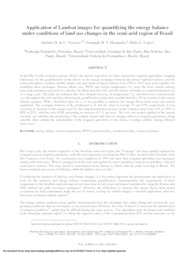Application of Landsat images for quantifying the energy balance under conditions of land use changes in the Semi-Arid region of Brazil.
Application of Landsat images for quantifying the energy balance under conditions of land use changes in the Semi-Arid region of Brazil.
Author(s): TEIXEIRA, A. H. de C.; HERNANDEZ, F. B. T.; LOPES, H. L.
Summary: In the Nilo Coelho irrigation scheme, Brazil, the natural vegetation has been replaced by irrigated agriculture, bringing importance for the quantification of the effects on the energy exchanges between the mixed vegetated surfaces and the lower atmosphere. Landsat satellite images and agro-meteorological stations from 1992 to 2011 were used together, for modelling these exchanges. Surface albedo (0), NDVI and surface temperature (T0) were the basic remote sensing retrieving parameters necessary to calculate the latent heat flux E) and the surface resistance to evapotranspiration (rs) on a large scale. The daily net radiation (Rn) was obtained from 0, air temperature (Ta) and short-wave transmissivity (sw) throughout the slob equation, allowing the quantification of the daily sensible heat flux (H) by residual in the energy balance equation. With a threshold value for rs, it was possible to separate the energy fluxes from crops and natural vegetation. The averaged fractions of Rn partitioned as H and E, were in average 39 and 67%, respectively. It was observed an increase of the energy used for the evapotranspiration process inside irrigated areas from 51% in 1992 to 80% in 2011, with the ratio E/Rn presenting an increase of 3 % per year. The tools and models applied in the current research, can subsidize the monitoring of the coupled climate and land use changes effects in irrigation perimeters, being valuable when aiming the sustainability of the irrigated agriculture in the future, avoiding conflicts among different water users.
Publication year: 2012
Types of publication: Journal article
Unit: Embrapa Semi-arid Region
Observation
Some of Embrapa's publications are published as ePub files. To read them, use or download one of the following free software options to your computer or mobile device. Android: Google Play Books; IOS: iBooks; Windows and Linux: Calibre.
Access other publications
Access the Agricultural Research Database (BDPA) to consult Embrapa's full library collection and records.
Visit Embrapa Bookstore to purchase books and other publications sold by Embrapa.

